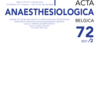Verification of two alternative do-it-yourself equipment respirator seal as COVID-19 protection (VADERS-CoV) : a quality assessment pilot study
respirator ; alternative ; N95 ; FFP2 ; Covid-19 ; quantitative fit test ; personal protective equipment ; snorkelling mask
Published online: Mar 29 2022
Abstract
Background : During the COVID-19 pandemic, healthcare workers were facing shortage in personal protective equipment, especially adequate respirators. Alternative do-it-yourself respirators emerged, without any proof of protection.
Objective : Verify seal potential of two alternative respirators compared to a common FFP2 respirator.
Design : Quality assessment pilot study.
Setting : Tertiary Care Hospital.
Participants : Ten anaesthesiology residents.
Interventions : Participants performed quantitative face-fit tests (QNFT) with three respirators to evaluate seal. A common FFP2 “duckbill” respirator was used as baseline (control group). Alternatives tested in this study were an anaesthesia face mask and a full-face modified snorkelling mask with a 3D-printed connector, both in conjunction with a breathing system filter.
Main outcome : Non-inferior seal performance of the alternatives over FFP2, assessed by calculated QNFT based on measured individual fit factors, as defined by the Occupational Safety and Health Administration.
Results :For each respirator a total of 90 individual fit factor measurements were taken. Within the control group, seal failed in 37 (41%) measurements but only in 10 (11%) within the anaesthesia mask group and in 6 (7%) within the snorkelling mask group (P < 0.001 respectively). However, when calculating the final, mean QNFT results, no difference was found between respirators. Successful QNFT were determined for 5 out of 10 participants in the FFP2 group, for 8 in the anaesthesia mask group (P = 0.25) and for 7 in the snorkelling mask group (P = 0.69).
Conclusion : Both do-it-yourself respirators successfully pass QNFT and have the potential to provide non inferior seal compared to a common FFP2 respirator. While anaesthesia masks are easily assembled, snorkelling masks must undergo significant but feasible modifications. Our results suggest that those do-it-yourself respirators seem to be viable alternatives for situations when certified respirators are not available but need further investigation for validation.
Trial registration: Clinicaltrials.gov
identifier: NCT04375774
Key Points : Question: Can alternative do-it-yourself respirators protect wearers from hazardous aerosols?
Findings : Our findings demonstrate that do-it-yourself respirators have the potential to provide non-inferior seal as compared to regular FFP2 personal protective equipment.
Meaning : Our real-life situational testing provides evidence that do-it-yourself respirators potentially provide sufficient seal to compete with or even outperform conventional FFP2 respirators and that face-fit testing should be a mandatory safety check in healthcare providers.
